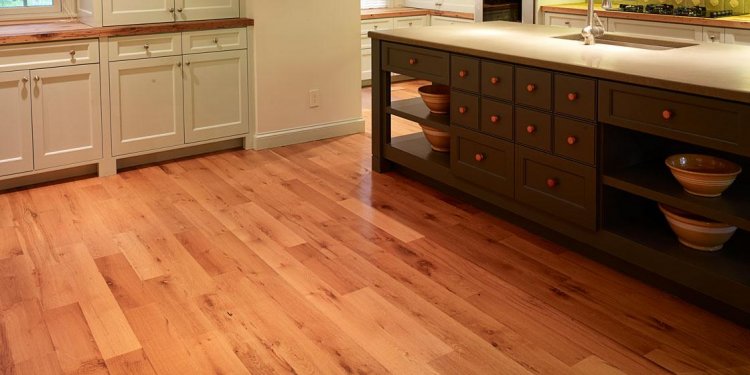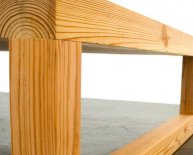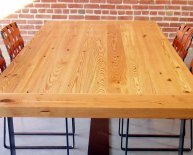
What is Reclaimed wood?
 What type of reclaimed wood do we use? We only use wood that is over 100 years old, we mainly use old growth heart pine. Here's a little history of the wood that we use to build our furniture. Before the American Revolution, longleaf pine, the source of heart pine, dominated the landscape in the South. Once the largest continuous forest on the North American continent, the longleaf ecosystem ran along the coastal plain from Virginia's southern tip to eastern Texas. There was approximately 90 million acres of long leaf, heart pine trees. These hardwoods had been slowly growing for centuries, typically only producing an inch of growth in diameter every thirty years. Most folks don’t realize that It can take up to 500 years for a longleaf pine tree to mature. Most of the wood that you find at your local lumber yard today is yellow pine that is less than 50 years old.
What type of reclaimed wood do we use? We only use wood that is over 100 years old, we mainly use old growth heart pine. Here's a little history of the wood that we use to build our furniture. Before the American Revolution, longleaf pine, the source of heart pine, dominated the landscape in the South. Once the largest continuous forest on the North American continent, the longleaf ecosystem ran along the coastal plain from Virginia's southern tip to eastern Texas. There was approximately 90 million acres of long leaf, heart pine trees. These hardwoods had been slowly growing for centuries, typically only producing an inch of growth in diameter every thirty years. Most folks don’t realize that It can take up to 500 years for a longleaf pine tree to mature. Most of the wood that you find at your local lumber yard today is yellow pine that is less than 50 years old.
The wood from old growth longleaf pine trees built a great number of structures in America and throughout the world, many of which still stand today. The exceptional quality of the longleaf pine was utilized in bridges, wharves, trestles, posts, joists and piles. Heart pine once framed four of every five houses in the Carolinas, Georgia and Florida, floored Thomas Jefferson's Monticello and George Washington's Mount Vernon. The wood was also used to build ships for the first English Navy, followed by the American Navy. The massive historical ship, the U.S.S. Constitution, has a keel made of a single heart pine timber, and its decks are made of heart pine planks as well. This ship, built in 1794, is the oldest commissioned ship in the U.S. Navy.
 Longleaf pine continued its historical impact with the ruling of King George II, who mandated that all straight pines exceeding 24 inches in diameter would be considered property of the crown. He then ordered his surveyors to brand the pines with his mark of a broad arrow. The colonists didn’t take too kindly to this mandate and they tarred and feathered the surveyors. Heart pine played a key role in the growth and development of the United States as an economic power. In the 19th century, heart pine was transported up the Eastern seaboard and over to Europe. The massive wood provided flooring, joists and paneling for homes and factories, as well as timbers for bridges, warehouses, and railroad cars. Also appreciated for its beauty, it was utilized in Victorian hotels and palaces.
Longleaf pine continued its historical impact with the ruling of King George II, who mandated that all straight pines exceeding 24 inches in diameter would be considered property of the crown. He then ordered his surveyors to brand the pines with his mark of a broad arrow. The colonists didn’t take too kindly to this mandate and they tarred and feathered the surveyors. Heart pine played a key role in the growth and development of the United States as an economic power. In the 19th century, heart pine was transported up the Eastern seaboard and over to Europe. The massive wood provided flooring, joists and paneling for homes and factories, as well as timbers for bridges, warehouses, and railroad cars. Also appreciated for its beauty, it was utilized in Victorian hotels and palaces.
Today, original-growth heart pine is extremely rare, with less than 10, 000 protected acres of original old growth Longleaf Pine forests remaining. Put another way, what was once 41 percent of the entire landmass of the Deep South, now covers less than 2 percent of its original range. Antique heart pine timbers are revered for their rich history as much as their beauty and durability. Sadly, clear-cutting of the vast southern forests in the late 1800s wiped out virtually the entire range of original growth heart pine trees. The only place to find the remnants of this antique wood is by reclaiming it from old buildings or finding it under water in the southern rivers used by many timber operations in the 1800s to raft their logs to nearby sawmills.
Since old growth heart pine is so rare, we are always on the lookout for an old house or barn that is being demolished or deconstructed. Then we go out and reclaim the wood and hand craft heirloom pieces of furniture that have an amazing history. We are fortunate to have the opportunity to build furniture with wood that is nearly "extinct". We love the history of this old wood and love being able to give it a new life.

















